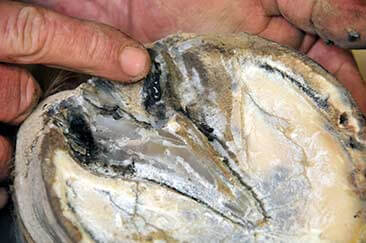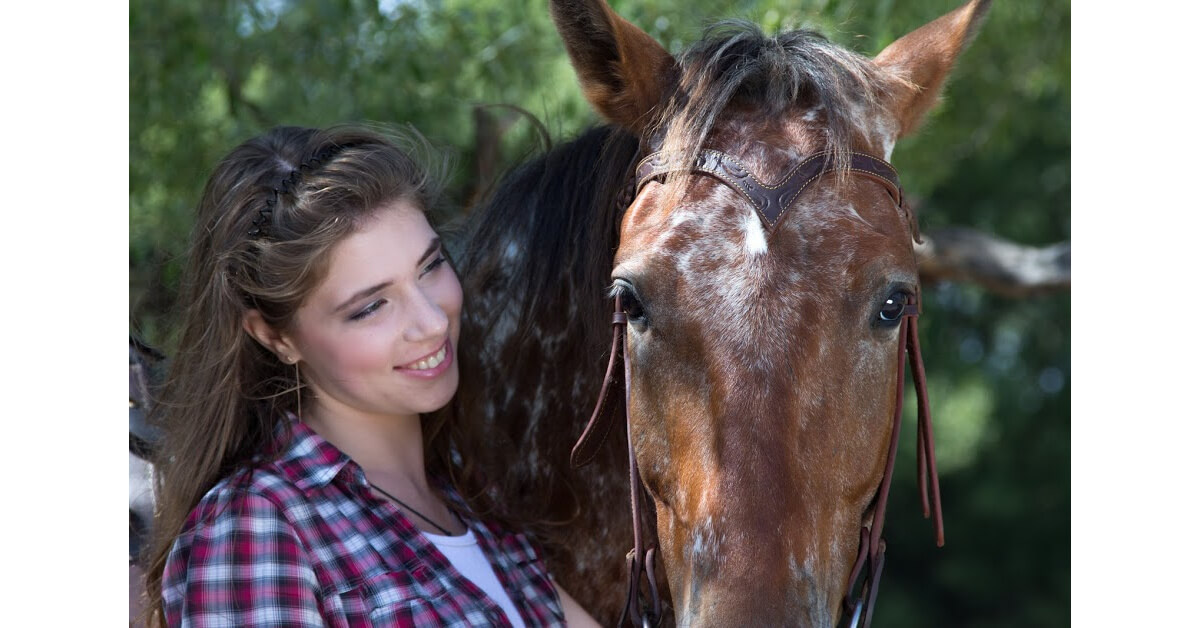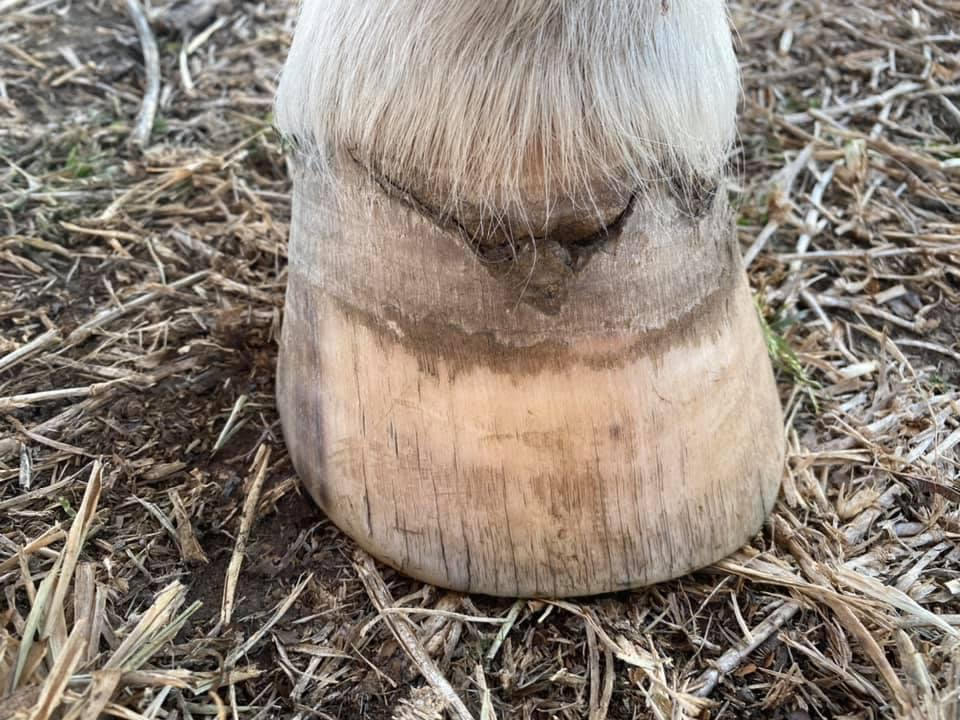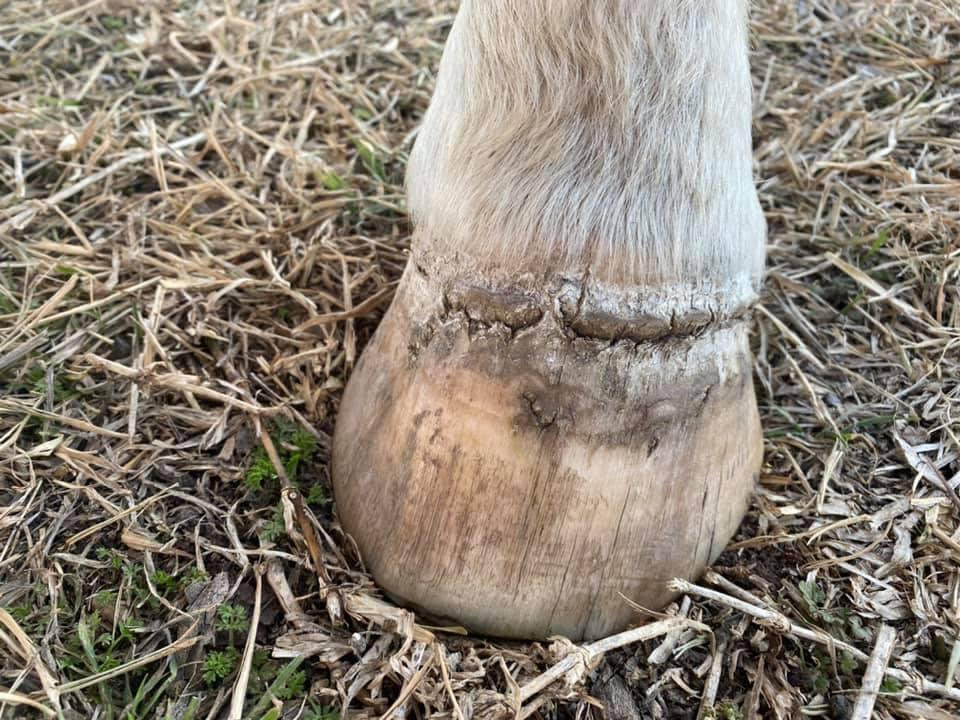New to Horses always recommends reaching out to your veterinarian regarding your horse’s health questions. The information provided on this blog should not be considered as a source to diagnose or treat any disease. New to Horses blog is purely informational, instructional, and entertaining.
If you read the previous posts, you know how to avoid many hoof problems in horses that can affect a horse. If you haven’t read about it in previous posts, there is no real order, go ahead and read this post and then hop over to the other.
As we talked about before in the last post, cleaning or picking out a horses hoof is the first step to healthy hooves
Below is a simple diagram of the bottom of a horse’s hoof. In the horse world, cleaning out the hoof is call “picking out the hoof. ” Mainly because we use a Hoof Pick to do the work.

horses hoof
The following is the list of four diseases, abnormalities and infections to be aware of
1. Thrush

Thrush in horses is a bacterial infection created by different fungi, microbes. It settles in the frog’s crevices and heal bulb of a horse’s hoof. The bacteria that causes thrush is naturally occurring and found in soil contaminated with moist organic material. This bacteria thrives in areas that are dark with no oxygen available. It finds its way into deep crevices surrounding the frog and heel areas with no blood flow to fight off the infection. There it sits and begins eating away at the tissues or rotting.
When cleaning out the hoof, it will smell rotten and you will start to see black substance. Again in the crevises of the frog and heel bulb area is where this bacteria grow.
If the horse shows soreness to touch or when moving around, call the vet to make sure you aren’t battling something else. They may recommend a different plan of action and pain medication.
Avoiding thrush
Cleaning manure and pee from areas a horse will be standing is one of the best and easiest preventative ways to avoid this disease. Make sure that when it rains, a manure pile does not run off into an area where the horse will be walking or standing.
Bacteria cause thrush, and keeping the areas of the hooves clean is vital to preventing this infection. However, exercise and activity help too. Turning a horse out is a great preventative if the horse is not ridden regularly. The movement itself will help clean out the hooves. A healthy, active horse is always number one to preventive care.
Consistent picking and cleaning a horse’s hoof can prevent this disease from occurring. During a regualr farrier visit, they will trim away loose pieces of the frog and heel area so that there are fewer areas for the bacteria to hide under.
Treatments for Thrush
A very reputable farrier has stated that it is better to clean and pick out the black substance. Keeping the area clean is more important than using a topical. Place the horse in a dry clean environment and clean the hoof well until it is controlled or eradicated. Continuing with exercise as long as the horse is comfortable.
As a horse mom, I know that we humans cannot keep ourselves from finding that one miracle-working topical. It is human nature to search for anything that will remedy a situation.
Most humans have been conditioned to use topical ointments on infections. It won’t hurt as far as I am concerned or have seen.
You want to start treating it as soon as there are signs such as a bad smell coming from the hoof. The black substance might not show up right away. It might be hidden deep in the crevices.
It’s ok to ride when a horse has thrush, as long as it is not painful. But, if the thrush is extensive, it can cause soreness, leading to lameness.
There are multiple topical treatments out there. I always used Kopertox. It was messy but quick-acting. There are many remedies out there, commercial and natural ones.
There are a number of products on the market for treating thrush, and I think it’s very important to be careful that you are using a product that is intended for this purpose. You don’t want to go out and just create all kinds of home remedies or buy into the home remedy game. It’s important to use something that’s mild and use it regularly. And that’s the key, is constant maintenance and attention is much better than trying to repair it after it’s happened-Danvers Childs, Farrier
https://www.smartpakequine.com/content/thrush-horse#p3s:120650&p3e:164600
2. Abscess

https://extension.umn.edu/horse-health/caring-your-horses-hooves
A horse that comes up suddenly lame. Lifting its leg, not wanting to put weight on it. These are the first signs you might see an abscess is brewing. Pain might not start till it’s ready to pop.
The abscess is a pocket of pus (infection). It can result from a bruise, a small stone that has entered the hoof, or a puncture wound. After, bacteria enter the hoof structures through the opening. White blood cells attack the bacteria and cause puss. The pus travels to an exit of least resistance. It cannot pass through the hoof wall, so it either finds its way out the soft coronet band or the sole of the hoof.
The only visible evidence might be a hole in the horse’s hoof where the infection has drained itself, and the horse didn’t even show signs. There still might be puss coming from it, meaning infection is still draining. Sometimes, there are no signs or symptoms to the event, even happenings. Your farrier will most likely find the telltale signs when he trims the horse.
Sometimes an abscess travels up to the coronet band and pushes its way through to release the infection. The coronet band is the soft band between the hairline and the hoof wall. It is the hoof’s softest part. More often than not, they will erupt through the sole of the hoof.
The below pictures show the results of an abscess that has erupted through the coronet band. These pictures are during the healing and new hoof growth process.
Here is a list of common reasons abscesses occur that are easily avoided.
- A puncture wound
- Bruising can also weaken the wall or sole of the hoof and make it easier for bacteria to get inside and become trapped.
- Poor hoof trimming can make a hoof unbalanced.
- Muddy ground can soften the hoof and make it easier to bruise.
- A rocky surface causing bruising
- Dirty wet stall or paddock areas can contain lots of bacteria
Treatment for an abscess
An abscess can go bad quickly. I suggest having a vet or farrier out to confirm the abscess and use their plan of action. Frequently they will say to let it run its course and if they need to intervene happens they will.
There are times when the abscess needs help in draining. When that time comes, the farrier or vet might make an opening to help it drain. Don’t try it on your own. Digging too deep or in the wrong direction may be catastrophic
There are certain poultice recipes out there that pull the abscess out. Soaking in an Epsom salt bath is another way to help the infection be released. A horse might need an antibiotic or pain meds.
Avoiding Abscess
Keeping paddocks and stalls free of debris that may puncture or bruise the hoof is a good way to avoid an abscess. Watch for stray nails from the barn or fencing. Clean up the pasture and paddocks, don’t leave trash pits, old motor parts, old wire fencing, etc., in where horses can walk through. If possible, avoid laying sharp-pointed stones like large limestone rocks where horses will be spending time, walking, or being ridden.
Horses are accident-prone. Don’t think of putting off picking an item up or doing it in the morning. Do it as soon as you see it!! Because it would be just your luck that your horse will find it too.
Suppose a horse that gets abscesses regularly. You might consider shoes and/or shoe pads. A farrier will help you decide.
3. Bruising

A heel bruise is a discolored spot at the site of an injury caused mainly by a rock. It’s not always on the heel. A horse may also have naturally thin soles or flat hoof that find it easier to bruise. It can be a common injury for horses that walk through gravel areas, trail ride, and wear no shoes. It shows up as a yellow, green, or red spot or line. A horse ridden on hard-packed ground, asphalt, or concrete can have its sole bruised.
It can occur anywhere on the hoof’s bottom, and the hoof’s an outside wall. Some bruises go undetected because the horse shows no pain. And others are severe enough to cause lameness. Most bruises heal quickly. But, some can turn into abscesses.
How to avoid bruising
Picking a horse’s hoof out regularly is a good way to keep rocks from getting stuck between the shoe and the sole, wall, and white line of the hoof, as well as stuck in the softer tissue of the frog, bars, and heal bulb of the hoof.
Getting a horse out of a pasture and not picking their hooves out is not good horsemanship Mud could seal rock to the sole of the hoof. That’s why cleaning them before or after a ride is so important.
Being aware of good footing can help prevent bruising. A reputable experienced farrier can help prevent over-trimming, which could predispose a hoof to easy bruising.
Horses with hard soles and conformation issues can be more prone to bruising. Be sure to ask a farrier before using a hoof hardener. Nutritional supplements and topical applications can help strengthen hooves, and horses can wear boots (see samples below in or shoe pads to prevent bruising.
Treatment for hoof bruise
Treatments for a hoof bruise depend on the horse’s history with previous bruising. However, most will heal with time. A vet or farrier might recommend anti-inflammatory agents, either by a supplement choice like MSM or prescription-strength like bute.
Packing the hoof in ice and a paste recommended by the veterinarian might help with pain. Just hosing with cold water might help relieve pain or swelling. As with other horse hoof problems, the horse might not be affected by the bruise.
4. Cracks

https://extension.umn.edu/horse-health/caring-your-horses-hooves
A prominent and easily detected hoof abnormality is a hoof crack. Like a human cuticle, the coronet band is where the hoof grows out of the bottom of a horse’s leg. If a crack involves the coronet band, it could have catastrophic results. With specialized vet and farrier care, it could be managed or cured.
The majority of the time, cracks run vertically and are found in the hoof walls. A vet or farrier should treat a crack that runs horizontally. X-rays may be necessary to determine how deep any crack is and whether it affects sensitive tissues like the laminae.
The majority of the time, a crack can be managed quite easily and does not cause any horse issues. There are many shapes, sizes, and directions to hoof cracks. When in doubt of the severity, take a picture and show your farrier and vet. They will either ease your mind or make an appointment to see the horse.
One might see cracks more with a dry hoof, dry climates, or a horse with inadequate nutrition if a horse is ridden on hard surfaces footings like asphalt, concrete, or a road base rock surface. Sometimes the wet weather that turns dry suddenly can cause cracks. Cracks can occur with injuries, such as trailering accidents, and frequently on the hoof with an overdue trim.
If a horse is shod, meaning they have shoes on. The loss of a shoe could cause cracks. The farrier should replace the shoe before any further riding. Luckily they do make boots for horses to wear. These can replace a shoe until the farrier comes. Below are some different styles of hoof boots.
Treatment for cracks
If a hoof is allowed to go past its normal trimming time or when that time is getting near, the new hoof grows, and the hoof wall may, like our own fingernails, extend over the soft finger pad. Our fingernails crack, and so do a horse’s hoof when there is not enough support from the interior sole. The hoof wall will begin to crack and maybe break and even break off completely. Most of the time, this does not hurt the horse; however, if the crack and break are high and deep enough, it can be a problem.
Most cracks that occur will be due to overdue farrier care. Those will be taken care of when the farrier trims the horse’s hoof. So simply keeping your farrier on a regular 6-week schedule should prevent.
Other cracks that are superficial (as diagnosed by farrier or vet) might grow out. They might also need the farrier to prevent the gap from getting deeper or extended. The farrier can place a shoe on the hoof with tabs to prevent the hoof from spreading out and making the crack spread open.
When a major crack is involved that affects the hoof structure, a farrier that is an expert on hoof abnormalities may be able to help better than the routine farrier.
How to avoid cracks
Good footing is so important to horses that have weak hoof walls. Like in bruising, the ground footing they are ridden on should be appropriate to their condition.
A horse with naturally brittle hoof walls may do good to have a supplement to build a strong hoof wall. And topical fortified hoof moisturizers may help.
Like the picture above, a crack can get caught on something and rip the hoof wall. A similar injury can be caused by a loose shoe getting caught on something and pulled. The damage could be superficial, or it could cause harm. Losing a shoe might or might not be prevented. If the horse’s hooves are picked out regularly, a rider will know if the shoe or nails are losing and should act accordingly, which would be to ride or not ride and call the farrier.
If a crack is deep, it may require medication to relieve the pain and restricted exercise until it is healed. Corrective shoeing will help a large crack. The farrier may use clamps to help the shoe prevent the crack from separating when the horse puts weight on it.
Below are samples of hoof boots that can protect and treat some horse hoof problems discussed in this post.
Hoof boots that can be ridden in
Horse boots used to soak a hoof
A horse’s owner, rider, lessee, or caregiver is responsible for preventative measures needed to care for a horse’s hoof.
As you can see, horse hoof problems can be prevented with good and basic hoof care, regular farrier trimming, proper nutrition, good footing, and clean living areas. Putting off getting help to a compromised hoof can lead to significant issues that may cause lameness and long-term recuperation periods. Don’t hesitate to take a photo and send it to your farrier or a veterinarian to ascertain the depth of the problem.
Can we see some pictures of your horse’s compromised hooves? Email them to me, and I will give you and your horse credit for the picture.
Watch for my next post about the Horse hoof disease laminitis and seedy toe




